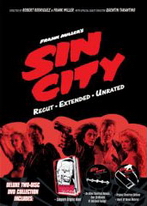
Arch
443/646: Architecture and Film
Fall 2007
Sin City (2005)

 |
Arch
443/646: Architecture and Film Sin City (2005) |
 |
Discussion Questions:
Remember, your images are ABOVE your name.
Please answer the questions below. Use paragraph form. Your answer should be around 400 words. Email me your responses in Word .doc format to: tboake@sympatico.ca I will be posting these each week after the class. You should be prepared to deliver your answer in class -- but paraphrase, do not read it. THINGS TO KEEP IN MIND WHEN ANSWERING THESE QUESTIONS: I am looking for general observations about the film and the relationship to any aspect of the Uncanny that we have examined. The images attached to your "words" are to clarify the intention but are not meant to be action specific. We are tying the films Renaissance and Sin City together.... |
| 1. | 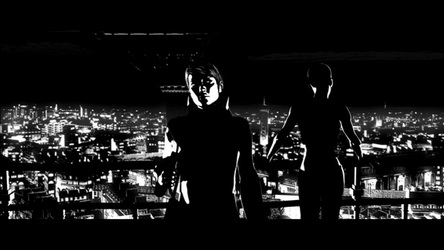 |
 |
|||
Adam Brady Sin City was initially shot in colour and then digitally re-mastered
into the final high quality, black and white style. This graphic technique
was used not only to portray the classic film noir style, but to pay
homage to the visual style of the original graphic novel upon which it
was based.
|
|||||
| 2. |
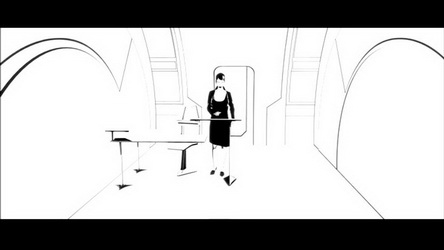 |
 |
|||
Cassandra Cautius In Frank Miller’s Sin City principal cinematography is color shooting
reduced to black and white with occasional color added back in postproduction.
The high contrast black and white enhances the comic book feel tying
the film closer to its printed original. The way in which white is used
specifically is not clear-cut.
|
|||||
| 3. | 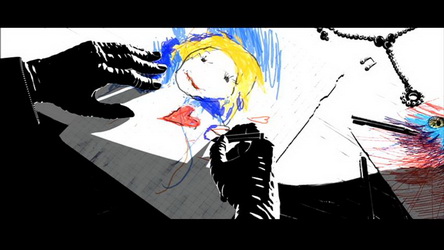 |
 |
|||
Alexander Chan In Sin City, colour is not scarce like it is in Renaissance. In Renaissance,
colour hints at an anomaly and intensifies itself like a shamanic vision
depicting events that previously unfolded. In Sin City, colour is used
to accentuate everyday things. In a way one can relate to the shoes in
red and the car in blue. The colour helps identify character’s
appearance because it can be hard to differentiate things in black and
white particularly film noir. However the colour also helps create a
sense of alienation and horror as seen in the blue of Becky’s eyes
and the yellow of the Yellow Bastard.
|
|||||
| x | 4. | 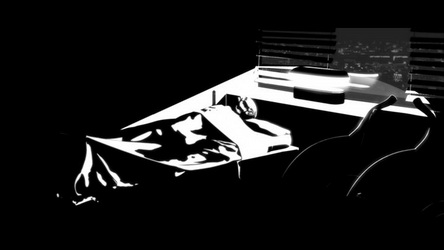 |
 |
x | |
David Henderson The visuals of Sin City, as in Renaissance, rely heavily
on the use of contrast. However, the perception of contrast differs between
the two films. In Renaissance, contrast was used to show intensity.
In SinCity, it is also used to show intensity but it
is also used to imitate the style of animation used in the comic book.
Although contrast is used to show intensity in this film, colour is the
primary feature used for emphasis. As colour has taken on the important
role of emphasis in this film, contrast is left to be used in a more
basic manner, that being focusing the viewer and drowning out the background.
|
|||||
| 5. | 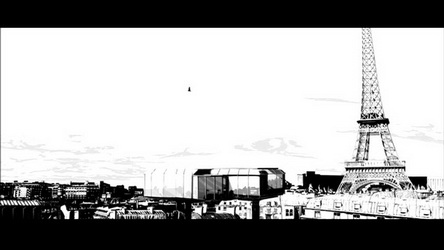 |
 |
|||
Minwoo Lee The fictional Basin City, better know by the attained title ‘Sin
City’, is the setting for the three short stories that compose
the movie. Although the three short stories occur in the same city, it
is difficult to notice a sense of collective identity in the city. Instead
of a definite collective identity, the city is composed of numerous districts
that impose their own autonomous presence in the city’s fabric.
The experience within these districts is very unique from the other,
each of them having their distinct physical features as well as the underlying
social structure and governance. Instead of creating a designed city,
the construction of the city takes on a purely functional motive. The
districts are designed as theatrical stages to support the diverse range
of narratives that take place and the collective urban identity becomes
irrelevant because the creation of Basin City serves only as to create
a fictitious boundary to enclose these stages in a physical setting.
Consequently, as the result of the lack of overarching design of the
city, the transition between the districts is visually abrupt and purposely
oversimplified in the movie.
|
|||||
| 6. | 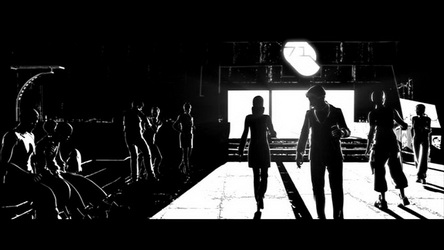 |
 |
|||
Paula Lee The animation film Renaissance by Volckman emulates life in futuristic Paris 2054. In its colourless view scope of flat black and white images, the effect of low-key single-source lighting that creates distinct silhouette draws depth and perception. Human figures are presented with varieties of outlined silhouettes, perpetually backlit and in many scenes their faces are half-lit chiaroscuros. As a result, the figures seem to sink themselves into background ink while the setting depicted without silhouette seem to pop out in its flat black and white scheme. The silhouettes also add the perception of reality to figures as the folds and wrinkles defined with this technique add the sense of motion and life. This draws contrast to the gesture of the city that looks rather lifeless and dramatic without vibrancy of motion. The images are either dominantly black or white, and in this setting silhouettes plays as a source of depth, giving life to the figures. The nuance of well-defined figures and flat setting seems to create a glandular gesture of emphasizing motion throughout the movie- sometimes the figures are the only part of the scenes viewers can distinguish. There is a sense of unbalance in the plays of black and white throughout the movie, as they represent the opposite, often creating a great contrast in tonal values making some of its scenes almost unrecognizable or flashy. The use of silhouette in Sincity is similar to that of Renaissance but it seems like all the scenes from the Renaissance have minimized details of texture all throughout the film, the scenes from Sincity either defines details delicately or uses stark black and white omitting any details to bring more dramatic effects to some scenes.
|
|||||
| 7. | 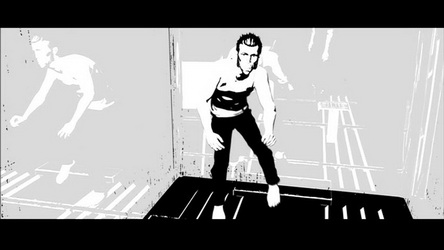 |
 |
|||
Evelyn Lo Both Renaissance and Sin City have both adopted the classic 'film noir'
style and have exaggerated it to create two visually stunning films that
through well crafted visual effects create a strong sense of the uncanny
throughout the films. Both films rely heavily on visual ambiguity to
prompt a sense of unease, disorientation, suspense and fear through visual
effects; reflections in Renaissance, and shadows in Sin City.
|
|||||
8. |
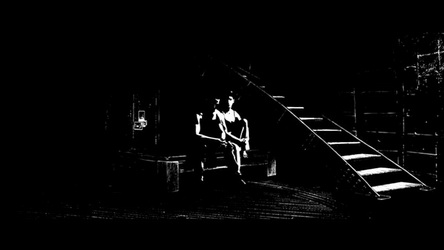 |
 |
|||
John McFarlane Spotlights are used in Renaissance and Sin City to create the sensation of isolation. They serve to disconnect the action from its surroundings by shrouding the peripheral material with darkness. The isolation that spotlighting creates is one of the ways that the films create a sense of “uncanny” in its sense pertaining to modern life in the metropolis: the individual alone in the crowd. Spotlighting is also commonly associated with performances so that watching a movie such as Renaissance or Sin City which portrays a plot as if it were real while simultaneously visualizing it in a way that suggests a staged presentation creates an uncanny disjunction in the mind of the viewer who is confronted with not only the ambiguity of the stylized reality portrayed in film but also the sense of unease inherent in the idea of people being watched emphasized by the spotlights. This condition the metropolis in which there are too many people to be acquainted with and social relations become abstracted as people become anonymous is a part of all the films we have watched so far, with the exceptions of The Cabinet of Doctor Caligari and The Golem, which portray an earlier way of life in smaller communities. While Metropolises 1927 and 2001, Playtime, Bladerunner, and The Fifth Element make use of the properties of this condition sometimes to further the plot (such as the polemic abstraction of ideas and people in Fritz Lang’s Metropolis) and sometimes almost unintentionally as an extrapolation of the current state of existence in the city, I, Robot and The Truman show play it up as a major theme. In I, Robot it is evident in the simplistic juxtaposition of Will Smith’s Spooner character, representing a nostalgic view of the past, with the world around him, a hypothetical demonstration of the condition of modernity driven by technological innovation. The Truman Show evaluates anonymity as well as surveillance in a more open-ended and less Manichean way by positing Truman’s artificial idyllic life as being in a town in which everyone knows him and comparing that condition to the reality of life outside the dome: millions of anonymous spectators watching Truman in order to capture the feelings of normalcy and social happiness that he embodies in his initial naivety. These two movies relate back to the use of spotlights in that spotlights are used to isolate the characters for surveillance while darkness represents safety. In this manner the benefits of anonymous existence can be read into the scenes in that the isolation spotlights create and which is symbolic of individual isolation in the metropolis can be taken away by the light which, in the act of isolating a character, defines them, strips them of their place as a face in a crowd, and bares them to the scrutiny of the power behind the light. The spotlight also refers to an authority of some kind in that that kind of lighting implies a strong source of light somewhere off the screen. The characters caught in the spotlight are in the presence of whatever power is its source, as in Renaissance in the scene in which the inspector is beaten by Avalon security after the doctor gets himself killed. After the inspector falls to the ground, the scene is seen from above, showing the doctor and inspector lying in the shallow snow illuminated by a harsh circular light from above. In this case the authority the spotlight represents is that of the Avalon Corporation, which has indirectly killed the doctor and directly battered the man trying to uncover its secrets. A similar effect occurs in Sin City, when the little girl is caught in the spotlighting of the door modified by the projected shadow of her captor.
|
|||||
| 9. | 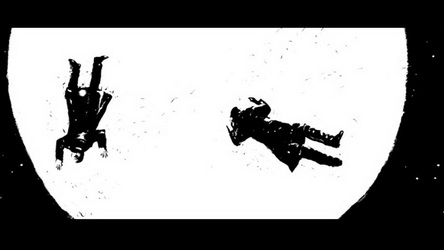 |
 |
|||
Sava Miokovic When a scene is set up from a high angle you experience it as an observer without a presence. You are like a hidden security camera, you see what is happening but you do not affect the course of action, rather you hold a detached standpoint. The high angles play up the idea of monitoring which comes across strongly in the film. The feeling of detachment that occurs when we observe something from above stems from the fact that we rarely interact with people situated below us. I am not saying this never occurs, but consider yourself standing on balcony overlooking an empty street. If someone were to walk by, you feel you have the full rights of the observer. Your situation in relation to them gives you the unspoken privilege to stare at the person, analyzing with your eyes, without any sense of guilt. This is why in the rare occasion that the observed turns his or her head and looks up at you, you are shocked, surprised at the meeting of your eyes, and might be inclined to quickly look away as if you were not staring. The high angle sets up a broader field of view, allowing you to observe multiple things at once. The object or character gets lost in their setting and thus become part of the wider picture. |
|||||
| 10. | 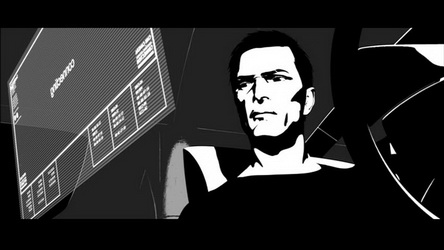 |
 |
|||
Reena Mistry SinCity, like Renaissance 2054, produces a modern adaptation of the visual style of film noir. The boundary between animated and live action film are blurred once more by the graphic style of the film, and the classic low-angle shots of both film noir and comic books produce the extreme view complementary to the intense characters, plot and cinematography. The low angle shot is used multiple times in the film to depict the view of the victim. The shot not only achieves the gruesome view of the killer’s emotionless face, such as the shot of Marv killing Cardinal Roarke, or Kevin looking down onto his next victim. Even when Hartigan awakes to find himself surrounded by surgeons in the classic hospital shot, the view is still that of the victim, defeated and physical harmed. Defeat is also captured particularly well by this angle. When characters fall to the ground, like Hartigan in the screenshot above, the angle of the shot captures an essence of pain, struggle and collapse. This was also evident in Renaissance 2054, when Karas is beat on the street by the corporate head of Avalon. The inferiority of view of the victim is the effect of the low angle which is also used to create a view of a superior or menacing character. This not only produces a distortion of size, but also of the surroundings. The subjects in the shot seem ominous, powerful and bigger – a notable characteristic of the shot in both SinCity and Renaissance 2054. This intensifies the character, scene and surroundings and plays into the surreal quality of these films.
|
|||||
| 11. | 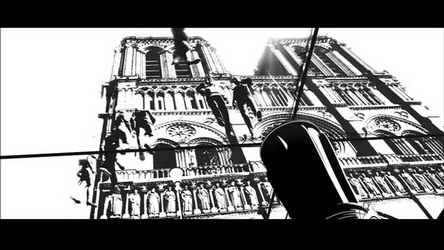 |
 |
|||
Melissa
Ng Architecture as part of the film Sin City is treated
as separate entities disconnected from one another as part of a metropolitan
site. The film, based firmly from the comic book, is depicted very
similarly to the comic where each scene has been filmed as if it were
drawn in a series of images. As the comic book has no context of
the surrounding city in its depiction, the context is added into the
film as the backdrop for these images to create a sense of realism. Also,
the architecture is not evidently linked to a city we recognize; the
narrative clearly takes part as part of a metropolitan area, but the
city remains indistinguishable. The icons, in turn, have
been created to resemble iconic artifacts of cities, yet it remains disconnected
from any famous icon from a city we know. The depicted cross at
the top of this spire hint to us that we are looking at a cathedral,
the women in the old town indicate to us a red light district, and the
dock tells us that there is a nearby body of water. All of these
are fragments of artifacts within a city. In contrast, the film
Renaissance uses iconic buildings such as the Notre Dame Cathedral to
further establish the narrative’s depiction of future Paris; the
iconic building has the ability to ground the story to a specific site
whereas in Sin City, the site is one of which is imagined and ambiguous. Furthermore,
the filmmakers had to advantage to create iconic places to allude to
the passionately violent nature of the film. The cross at the top
of the cathedral is can be seen as a barrel of a gun, with the cross
as the crosshairs of the directed shot. This is also uncanny in
the sense that because of the angle of the shot, the top of a sacred
place can also be perceived as the symbol of death and violence. |
|||||
| 12. | 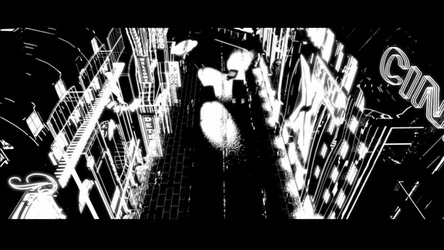 |
 |
|||
Aisling
O'Carroll The 'old city' in Frank Miller and Robert Rodriguez's film Sin City plays
a different role than the 'old city' seen earlier in Renaissance.
Volckman's film Renaissance is set in a future Paris, and the
old city presents recognisable remnants of Paris. This creates a historical
framework for the film. In the case of Sin City, the action
takes place in the fictional setting of Sin City itself. Thus, when the
set enters Old Town, the old city is not creating a reference to a specific
city we recognise. In this case the old city references a typology of
city, and a condition to which the audience can relate and recognise.
|
|||||
| 13. | 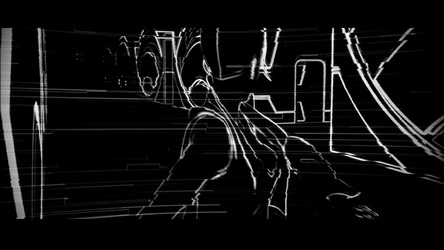 |
 |
|||
Shannon Ross |
|||||
| 14. | 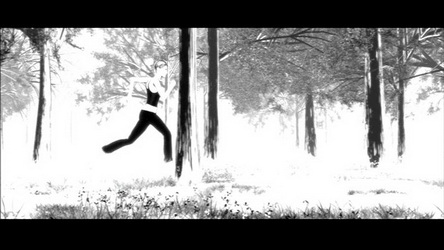 |
 |
|||
Terry
Sin Both Renaissance and Sin city are films about contrast. One such contrast is between the built and natural world. In both films, nature seems out of place or chaotic compared the built world. While the urban environments presented in the two films may seem chaotic to the audience; to the characters in the film, the built world is the familiar and can be understood. In both scenes where nature is present in Renaissance, trees are used to disorient or confuse the characters. The vestibule to Jonas Muller’s apartment is a presented as a grassy forest and is a striking contrast to the built world surrounding it. Since nature is barely present in the movie, this scene makes the viewer question why there is a forest in an apartment and where the other forests are. In the following action scene also utilizes the trees as blocking, hiding and revealing the enemies and hero throughout the shoot out. Similarly, in the scene where Ilona is held captive, a simulation of a forest is effective in disorienting the character. Compared to the built world she is used to, there is no order or recognizable landmarks and ends up running aimlessly. Nature again seems out of place and uncomfortable, especially because in this case, it is not even real nature. Its formation is an unnatural time lapse growth from nothing. It both cases it is also chilling to believe that trees and plants are so rare that they are only present in simulations or in the penthouse apartment of a wealthy scientist. In Sin City, nature can also be observed as an unfamiliar and haunting place. The farmhouse and its surrounding forest are uncharted. Only the sinister inhabitants of the house understand the lay of the land. Marv, who usually has the upper hand in the city, is easily defeated in the forest. The forest and the actions associated with it in the movie make nature seem eerie and disturbing. In a way, the natural world depicted in Renaissance and Sin City seems unnatural. Since the rest of the world is built, nature seems out of place. In order for it to be present it needs to be built itself, thus making it feel even more unnatural than the built world. All the built areas of Paris seem to have a natural evolution, such as the glass layers, but the natural element seem static and placed. The city in Sin City is familiar to both the audience and the characters, yet the disturbing violence present in the forest makes nature uncanny. Nature should seem like something that is comfortable, or least, natural. Also, in Renaissance, the natural world is artificial, replacing common notions of nature, similar to the idea of an animal in Blade Runner.
|
|||||
| 15. | 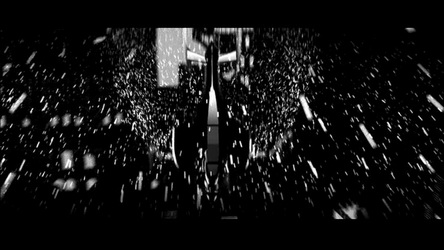 |
 |
|||
|
Paris depicted in Renaissance 2054 is one of control and surveillance in which contemporary society is imposed on in every way by the youth and beauty company Avalon. Rain in this film is something beyond human control which can help characters find some higher ground out from the control of the systems of surveillance. It makes some hidden things visible and some audible things invisible. The appearance of rain appears mainly when there is some stealth going on that muffles the sounds of people to the unsuspecting target. The rain often helps us identify the whereabouts of Avalon’s invisible henchmen because of the rain splashes that could be seen around their person even if we could not see them ourselves, this effect of the outside world beyond Avalon’s control made them visible. Basin City is controlled by the Rourkes and the girls of Old Town. It has become a city of corruption, greed, murder and deceit. Sin City is spiraling out of control and seems like quite a dangerous place to live. Rain in this film seems to mean many things. Much like Renaissance it sometimes symbolizes sinister things afoot. For example most of the rain takes place during the story of Dwight and Jackie Boy. The rain is telling us that there are things hidden from us in the story that we will find out later, and that the main characters have plans to set things right in their eyes. We can see this in Dwight’s story when he’s trying to get rid of the evidence of Jackie boy’s murder to save old town. Rain appears whenever he seems to be formulating or carrying out his plan that we can’t quite tell what it is yet or something uncanny is happening. A good example of this is when he is driving to the tar pits and Jackie boy starts talking to him even though he is dead and his head is almost chopped off. We don’t know if this is in Dwight’s head or if it really happening. Also, when Dwight is at the tar pits it is raining, and he is ambushed by the mercenaries. This shows some hidden sinister activity that is afoot. Also, when Dwight is exchanging Jackie boy’s head for the women of old town it is pouring with rain. This lets us know that Dwight has something else planned, there is something hidden from us. And indeed, he has hidden a bomb in Jackie boys mouth and the girls of old town are part of an ambush to take the police unawares so they can take back old town. Another part of the film where rain was important was when Marv was walking on the bridge in the rain when he was trying to find out about Goldie’s killer. His search led him to the Rourkes and he is trying to formulate a plan to get revenge for his lover’s murder. The rain symbolizes his search for the truth.
|
|||||
| 16. | 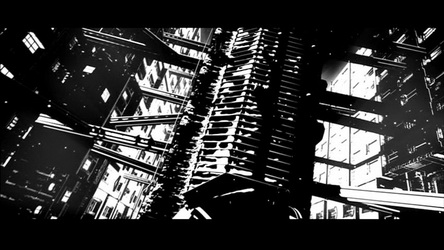 |
 |
|||
Jamie
Usas The representation of materials in Frank Miller's Sin City, directed by Robert Rodriguez, add a quality of realism undefined in Christians Volckman's Renaissance. Unlike Renaissance, which is represented with extreme sterility, Rodriguez achieves, through the rendering of materials, a layer of realism that can only be characterized as a “gritty film of sleaze”. By emphasizing the abject (dirt and grit) Sin City touches on levels of the uncanny associated with the unclean and the morally or spiritually unpure. The abject representation of materials in the film persuade the viewer to feel uncomfortable, or unclean, and intensifies the viewers absorption into the world of Basin (Sin) City, and therefore making the viewer more responsive to the underlying themes of corruption and redemption that run throughout the three story-lines of the film.
|
|||||
| 17. | 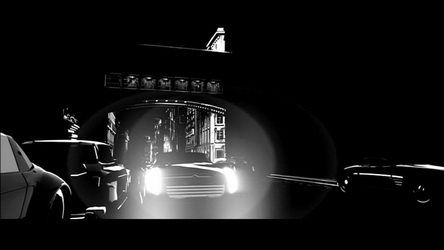 |
 |
|||
Susan Varickanickal The automobiles in Sin City, like in the film Renaissance, play an integral
role in connecting the viewer to the film. In the film Sin City however,
the automobiles clearly show the state in which the city is. Basin
City is full of corruption, and the progression of technology is stagnant. By
using older models of cars, most pre-dating the 1980’s, the director
clearly illustrates the idea of a decrepit city where social and technological
development seizes. The automobile not only depicts the state at which
technology has advanced but also the advancement of social activities. The
car is not seen in the same manner as in Renaissance. It is now a luxury
rather than another toy.
|
|||||
| 18. | 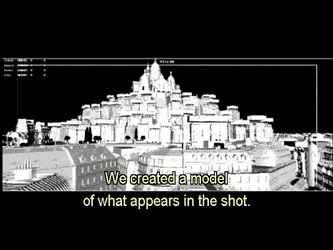 |
 |
|||
Chao
Lun Wang Robert Rodriguez’s Sin City and Christian Volckman’s Renaissance 2054 are two distinct films that are produced primarily in a digital back lot to present live actions in imaginary settings. The stylization of the two films are quite unique. Renaissance 2054 is stylized to be a black and white computer animation while Sin City is stylized also in black and white, but to it aims to translate style of Frank Miller’s graphic novel of the same title. The artistic stylization in the two films all attribute to aspects of the uncanny. First, the animated visual style in Renaissance 2054 is produced with motion capture of real actors with computer generated imagery. This distinctive method led to some quite uncanny aspects. For example, the rendering of faces of characters is particularly strange. Since the facial expression of actors were captured digitally with dots marked on their faces, their expressions has been simplified as pure motion. The soul of the expression is not translated. Consequently, the characters appear to be human yet still not convincing enough to have souls. So the film is composition of these soulless humanoid charcters, good and evil, to convey an outrageous plot that makes the world as a whole seems mad. On the other hand, the film Sin City incorporates real actors performing live actions in CGI environment, and later stylized to resemble a Manga. This stylization allows the filmmaker to interplay between the homely and the unhomely. The most stylized Manga scenes occur as silhouetted figures over a 2D black and white background. These are often the most violent scenes of the film, such as when Kevin gets devoured by a hound, and when Jacky’s throat gets sliced. Rodriguez emphasizes on the motion of the violent acts, and leaves out the rest to the viewer’s own imagination or experience, making the scenes an available canvas for people to montage upon. This stylization is uncanny since it draws upon our own imagination to realize the scenes.
|
|||||
| 19. | 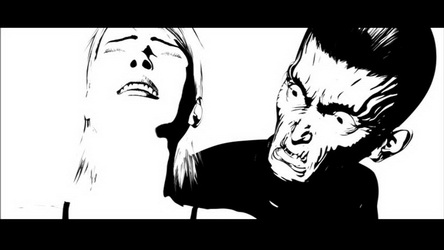 |
 |
|||
Benjamin
Wong Renaissance and Sin City are both films that rely heavily on the exaggeration of the characters’ faces as portrayal of their personas. What is interesting is how the creation of the physical appearance of the characters plays a large role in plot development. The first image is of Klaus and Ilona, from Renaissance. Through the use of positive and negative space in the image composition, the contours of the wrinkles on Klaus’ face are exaggerated to show his physical condition; although mentally maturing, Klaus is forever trapped within a sick child’s body, ravaged by progeria. In terms of physical traits, Ilona’s face is quite opposite to Klaus. She appears youthful, and the audience at first perceives her to be the victim of a conspiracy. By the end of the film, however, the audience quickly realizes that the faces of the characters have really been a deception. Klaus’ features, which might typically be associated with the role of the antagonist, do not reveal the Klaus whose character was too gentle and compassionate to kill Ilona in the end. Ilona, however, is eventually revealed as the real criminal of the film. Sin City was quite similar in the ambiguous differentiation between the “good” and “evil” characters. Marv is a good example of this film’s similarity to Renaissance. Marv, although carrying the appearance of a monster, is actually the kindhearted and virtuous renegade hero. Becky, the Old Towne girl who betrayed her comrades, also shows character traits that conflict with an audience’s reading of her docile appearance. The idea of the “uncanny valley” plays into Renaissance, greatly due to the fact that the characters are completely animated. The animation of the characters are so close to being real, as the animators have tried to mimic real human expressions as best possible. Even so, there is a prevalent rigidity in the characters’ facial movements that people are not naturally trained to understand. This is the key element that allows the audience to see the animated characters as nearly human, but off enough to cause an uneasy reaction, as discussed in Doctor Mori’s thesis of the “uncanny valley”. This is even more evident in Sin City. More notable is the appearance of Jack Rafferty, as his dead corpse comes alive and converses with Dwight. What is uncanny about Jack is how it allows the audience to identify with the human appearance, but also causes eerie feelings when the audience notices the slit in Jack’s throat. The Yellow Bastard, with his sinister appearance, is perhaps the most dramatic example of the uncanny seen in the film. His facial features are so human, yet certain parts are grossly disproportioned and distorted.
|
|||||
| 20. | 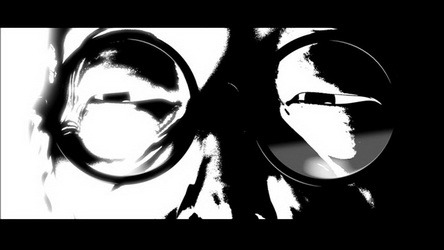 |
 |
|||
Erin
Corcoran The Eye can often be considered as a “window into the soul”, or a symbol of transformation, like the “eye of a tornado”. Within “Renaissance”, eyes are rendered in both realistic and graphic forms depending on the personality of the individual, and how trustworthy they are to be considered by the viewer and the other characters. In this way, the rendering detail of the eye is understood to document the condition of the character’s soul, as trustworthy individuals are displayed with more realistic eyes (with eye lashes and pupil / iris definition), and questionable persons are given fake-seeming or over-simplified eyes (a simple black outline and a darkened iris). Within Sin City, eyes are treated in a different fashion, but still one relying on the understanding of the eye as the viewing platform of the soul. However, it is in Sin City that the second definition of the eye, the symbol of transformation, is used as well. Eye shots are used throughout the film, but there are two poignant moments in which the eye plays more of a symbolic role; the first is during the death of Marv in the electric chair, and the second is during the near-death of Hardigan by hanging in the hotel. In the case of Marv, as he finally dies, the camera zooms in onto his eye and shows an image of him and Goldie before fading to black as the story ends. In this case, the eye is used very literally as a ‘window to the soul’ providing the viewer a very specific glimpse into Marv’s final thoughts. Within Hardigan’s tale, as he is hanging from the ceiling of the hotel room, he passes out, saying, “This is it, this is the end.” and, supposedly, dies. But the story isn’t finished yet, and the camera, focused on his eye as it opens, catches his determined glare as he decides to fight once more. In this case the eye is more like the eye of a tornado, the calm, witnessing center of a storm of survival; but at the same time, it is also a glimpse into Hardigan’s motivations and insatiable need to save Nancy again, and again. Within both these movies the basic symbol of the gateway to the soul is employed in different ways through the use of the character’s eyes. Within Renaissance, this distinction is more visual, whereas in Sin City both eyes are rendered the same but the viewer is expected to understand the very different motivations and desires driving both Marv and Hardigan’s souls.
|
|||||
| 21. | 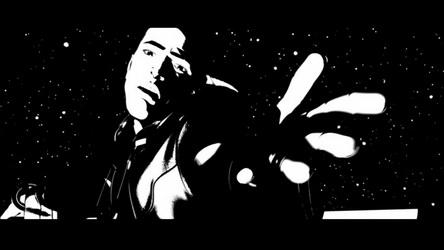 |
 |
|||
Matthias
Heck Taking a closer look at emotions and their representation in Sin City, one can see that extreme emotions like anger, pain, hatred, despair or madness make up the majority of the depicted feelings. Compared to Renaissance, one can conclude that in a certain way both movies have the same emotional central theme as they play with the same set of human feelings and interaction. This is probably due to the fact that both movies are settled in the same related genres, and rely on film noir characteristics in terms of the story and the characters: we find the attractive and seducing femme fatale, the conscience-stricken male protagonist that is a cynical loner, introverted, hard-boiled and/or mysterious. This leads to a limited plot development and the above mentioned emotional central theme. Although both movies rely on a similar set of emotions, the main difference to the Renaissance movie is the intensity of actions and emotions. Stronger physical actions of the characters lead to stronger emotions in Sin City, leading up to a bizarre point where the emotion is negated (many characters hardly show any emotion at all, for example Owen as cold-blooded Dwight or Rourke as Marv) or feelings are suppressed. This especially applies to the feeling of pain (Kevin being fed to his own wolves, Hartigan being shot several times, Marv being hit by Wendy, etc…). Furthermore, the emotions quickly change from one extreme to another extreme, for instance with Marv, who undergoes a change from grieving for Goldie to coldbloodedly killing and torturing people, which creates a more blatant feeling compared to Renaissance. On a graphic level, Sin City works in a similar way as Renaissance does (or even more as a graphic novel) with the usage of a black and white contrast and special effects to enhance the effects of emotions via gestures or facial expressions. Although Sin City is more intense in terms of its content, the graphic depiction of emotions is probably stronger in Renaissance. The reason for that is mainly the stronger and more reduced contrast of the whole movie (in comparison to single sequences in Sin City). In addition, the above mentioned negating of emotions combined with the high level of gore and violence in Sin City works against an emotional response on another level.
|
|||||
| 22. | 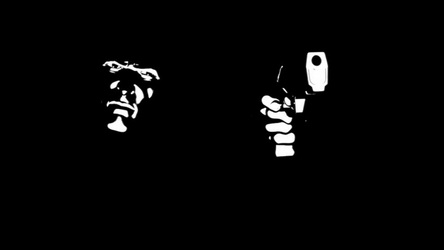 |
 |
|||
Suzanne Gibson The film Renaissance 2054 is saturated in violence, with each act of violence being brief and intense. The monochrome tone of the film is raw and primal, the graphics being hard edged and for the most part the images are rendered in black and white with little grey and almost no color, although the violence occurs in short spurts the graphics render it beautifully, conveying the darker recess of the human condition without the gore that is typically associated with most modern movies. The director also takes advantage of camera movement, grand swooping shots add to the tension and energy adding a third dimension to what would otherwise be a two dimensional rendering of space. As seen in scene with the car chase, which begins with a bird eye view, the camera then swoops down below grade to the metro. The metro has a glass ceiling with a pedestrian walkway above; the layering allows the camera to tack the movement of both the police officer and man he is chasing even though they are on different levels, the choice of layering creates a tension that results in dynamic and fluid chase scene that paces the actions. The police offices then pulls his gun and tries to shot the man he is chasing, the hard angle of the camera shot betrays the frustration of the officer at being unable to hit his target, and the people below scatter at the sounds of the gun fire. Sin City, like Renaissance 2054 is violent in the extreme. Both films share a few commonalities, both are primarily monochrome and both are highly stylized. Yet despite the similarities, the violence in Sin City does not share the same eloquence of Renaissance 2054, rather it is, in your face brutal relishing in gore ranging from limbs being chopped off and fed to dogs, decapitation, mutilation, cannibalism, and of course the typical run of the mill beating and gun violence see in many Hollywood movies. But what really sets Sin City apart is comic book flavor, from the monochromic tones with bits of color to the one liners like, “a soul send screaming into hell” and “a hard good bye.” These one-liners take the edge off the violence, and make the film comical. The tongue and cheek humor with which violence is presented in Sin City also makes it less horrid. My personal favorite is the talking head that has to have his mouth taped to keep him quiet, there are several of these funny comic moments of violence through out the film. Unlike most gore movies, Sin City’s violence is engaging the black and white film has burst of crimson, gold, and in very few occasions blues and greens. Color is used as an indication of violence to come, the women in the red dress who is killed, the prostitute with her yellow hair and red bed whose death results in the brutal beating of many, the yellow monster who prays on young girls raping and killing them. Color is also used to indicate forth-coming bloodshed. The red, blue and green flashing lights on the drive to the tar pit just before a brutal fight, the greens eyes of the priest who eats the flesh of prostitutes, the blue eyes of the prostitute that double cross her peers and gives them over the gang, and lastly the yellow eye of the gangster whose entire gang is slaughtered. In this dark movie violence is foreshadowed by color, and color is also used to amply the effects of violence. Blood is highly stylized being either depicted as red, black and / or white. Blood is red on those characters that are enraged and that have the potential to fight, while it is either white or black on those who are not fighters. |
|||||
| 23. | 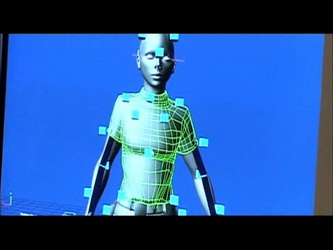 |
 |
|||
Kate Gould The two movies Renaissance 2054 and Sin City both used state-of-the-art CG technologies to combine live-action filming and unique post-production editing to produce their films. Both had distinct atmospheres, which remain true to a comic book or graphic novel form of representation, such as those by Frank Miller. These films are particularly uncanny when compared with other animated films, as they are very so graphic, concentrating heavily on the realistic depiction of human emotion. Filming Technique Post-Production Result
|
|||||
updated 25-Dec-2007 3:42 PM